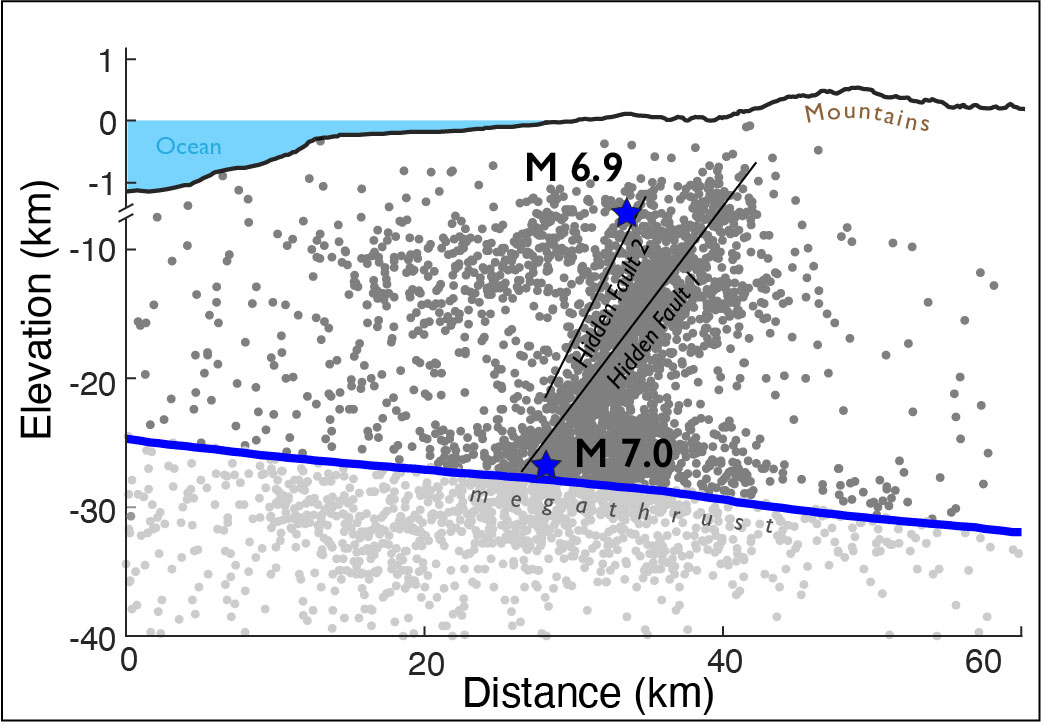The element of surprise can make earthquakes on subsurface faults especially dangerous.
By Laura Fattaruso, Simpson Strong Tie Fellow (@labtalk_laura)
Citation: Fattaruso, L., 2022, Hidden faults pose a hazard to major cities around the world, Temblor, http://doi.org/10.32858/temblor.277

On March 11, 2010, minutes after the newly-elected President of Chile, Sebastián Piñera, had been sworn into office, a magnitude-6.9 earthquake rattled the capital city of Santiago, followed by a magnitude-7.0 quake 16 minutes later. Merely 14 days prior, Chile had been rocked by the magnitude-8.8 Maule megathrust earthquake, which devastated much of the country and generated a destructive tsunami.
Geologists sent to the Pichilemu region — where the pair of March 11 earthquakes originated — could find neither surface ruptures nor signs on the ground of the fault that had caused the shaking. Julius Jara-Muñoz, lead author of a recent study published in Nature Communications on the topic, calls the mysterious structure a “cryptic” fault — one that does not reach the surface, but nonetheless poses a major hazard. “Blind fault” is the most commonly used term, but such structures are also called “hidden faults.”
Note: Temblor acknowledges the potentially harmful use of the term “blind faults.” This story will reference hidden faults instead.
These faults are problematic because they are unidentified structures that can cause damaging earthquakes, Jara-Muñoz says.

Hidden faults cause major problems for big cities
Many notable earthquakes in recent history have been generated by hidden faults including:
- 1989 Loma Prieta earthquake outside San Francisco (magnitude-6.9)
- 1994 Northridge earthquake in Los Angeles (magnitude-6.7)
- 2010 Canterbury (magnitude-7.0) and 2011 Christchurch (magnitude-6.2) earthquakes in New Zealand
- 2015 Gorkha earthquake in Nepal (magnitude-7.8)
- 2010 (magnitude-7.0) and 2021 (magnitude-7.2) earthquakes in Haiti
Scientists don’t entirely understand why some faults breach Earth’s surface and others do not, but the material at the surface is one influential factor, Jara-Muñoz says. Many hidden faults occur in sedimentary basins — such as the Los Angeles basin — where the fault tip is buried beneath thick sediments that fold rather than break. Many active subsurface faults in the Los Angeles metro area have been found using seismic imaging, but that process is expensive and requires knowledge about where to look.

Other hidden faults, such as the Pichilemu Fault in Chile, cut through metamorphic or crystalline rocks that have experienced previous deformation that may diffuse the fault movement over a wider area at the surface, according to the study authors. The researchers found evidence of previous ruptures of the Pichilemu Fault using uplifted marine terrace deposits. When the fault ruptured in the past, these layered sediments deposited above the fault were moved upward relative to sea level. By correcting for past sea level changes, the researchers could estimate how much movement had occurred in previous events and determine a recurrence interval — the average time between earthquakes on a fault. They found that the Pichilemu Fault has likely hosted an earthquake approximately once every 2,000 years. With such infrequent activity, clues in the landscape of previous earthquakes are virtually erased by erosion between each event, making it difficult for researchers to identify future hazard.
Devastating consequences
On January 12, 2010, Haiti’s capital, Port-au-Prince, was struck by a magnitude-7.0 earthquake, which devastated the country. Though the death toll remains disputed, estimates of fatalities range from between 220,000 and 316,000, making it one of the deadliest earthquakes of the century.
Eleven years later, another earthquake struck Haiti — this time further from the densely populated capital—that shared many geologic characteristics with the 2010 quake. Both temblors originated on hidden thrust faults near a larger strike-slip fault, the Enriquillo-Plantain Garden Fault. Haiti has two major visible faults that run east-west — the Enriquillo–Plantain Garden Fault in the South and the Septentrional Fault in the north. Before 2010, geologists thought these two faults posed the greatest seismic threat in the region. Since then, though, two quakes have occurred on secondary faults — the magnitude-7.0 earthquake of 2010 and the magnitude-7.2 earthquake of 2021 — raising the question of whether there are many more unseen faults that pose a danger.
“How well do we know those secondary faults?” asks Roby Douilly, a seismologist at the University of California, Riverside. He is using data from a campaign to install small seismographs throughout Haiti that could pick up smaller earthquakes and help identify these faults before they host a larger quake. This is part of a community-based science effort in which small, relatively cheap seismic stations called Raspberry Shakes are mostly hosted in people’s homes. Installation of larger, more sensitive seismographs is expensive and requires long-term upkeep that is difficult to fund and maintain. Douilly says he hopes that more data will be collected over a longer period through these partnerships between scientists and the community.
“Those [hidden] thrust faults can be more devastating,” Douilly explains. “Because they don’t reach the surface, we may not know anything about that hazard until it occurs.”

Laura Fattaruso is Temblor’s Simpson Strong Tie Fellow. They are a Ph.D. candidate at U Mass Amherst, where they study how rocks break to better understand earthquake processes (laurafattaruso.com). Simpson Strong Tie is sponsoring a science writing fellow to cover important earthquake news across the globe.

References
Jara-Muñoz, J., Melnick, D., Li, S., Socquet, A., Cortés-Aranda, J., Brill, D., & Strecker, M. R. (2022). The cryptic seismic potential of the Pichilemu blind fault in Chile revealed by off-fault geomorphology. Nature communications, 13(1), 1-13.
Calais, E., Symithe, S., Monfret, T., Delouis, B., Lomax, A., Courboulex, F., … & Meng, L. (2022). Citizen seismology helps decipher the 2021 Haiti earthquake. Science, 376(6590), 283-287.
- Magnitude 7 Yukon-Alaska earthquake strikes on the recently discovered Connector Fault - December 8, 2025
- Upgrading Tsunami Warning Systems for Faster and More Accurate Alerts - September 26, 2025
- April 2025 magnitude 6.2 earthquake near Istanbul highlights strengths and weaknesses in seismic mitigation - September 14, 2025
